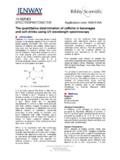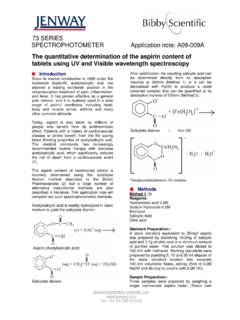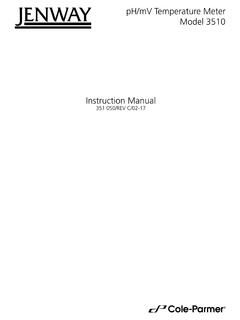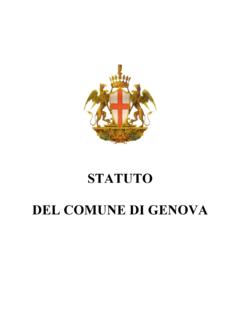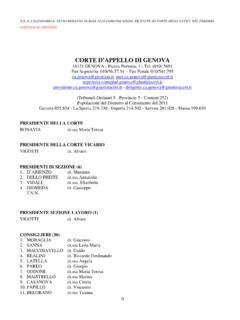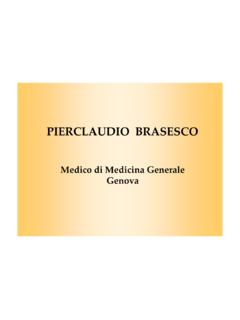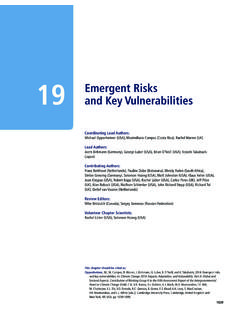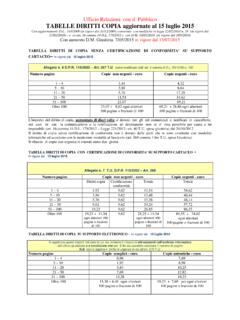Transcription of Genova Protocol: P09-003A - spectrometer| Jenway
1 Genova protocol : P09-003A . Bradford Protein Assay Introduction The Bradford reagent1 consists of the dye Brilliant Blue G in phosphoric acid and methanol or ethanol. Brilliant Blue G forms a complex with proteins in solution resulting in a shift in the absorption maximum of the dye from 465 to 595nm. The absorption is proportional to the amount of protein present. This reagent can be used to quantify proteins in the concentration range from to approximately The Bradford assay is compatible with reducing agents such as dithiothreitol; however it is only compatible with very low concentrations of detergents. If the samples contain detergent then the BCA assay is recommended. It is always advisable to prepare the standard in the same buffer as the sample to minimise any interference effects. The dye reagent reacts primarily with arginine residues and less so with histidine, lysine, tyrosine, tryptophan, and phenylalanine residues.
2 Compared to average proteins, the Bradford 2. assay is more sensitive to bovine serum albumin, by a factor of about two . Immunoglobulin G (IgG - gamma globulin) is therefore the preferred protein standard. Materials required Bradford Reagent (Sigma B6916). Suitable tubes to hold and mix samples Plastic disposable cuvettes ( Jenway 060 084). Standard protein solution of known concentration (2mg/ml). Method Preparation of the Bradford reagent The Bradford reagent is available commercially from a number of different sources. However it can be prepared as follows: 1. Dissolve 100mg Coomassie Brilliant Blue G-250 in 50ml 95% ethanol, add 100ml 85% (w/v). phosphoric acid. 2. Once the dye has completely dissolved, dilute to 1 litre with deionised water. 3. Filter through Whatman #1 paper just before use. Preparation of samples and standards 1.
3 Turn on the Genova and allow it to warm up. See below for set up instructions. 2. Gently mix the Bradford reagent and bring to room temperature. 3. Prepare a series of protein standards ranging in concentration from to such that the final volume for the assay is Examples of dilutions are given in Table 1 below. Note that the Genova can accept up to 6 standards, not including the blank. 4. Prepare the unknown samples in a similar way such that the final volume is 5. Add of Bradford reagent to each sample and standard, vortex and incubate at room temperature for 5 to 45min. The protein-dye complex is stable for up to 60 minutes. Tel: +44 (0)1785 810433. 6. Transfer the samples to cuvettes and measure the absorbance at 595nm using the Bradford protein mode on the Genova as detailed below. Final concentration Volume of a 2mg/ml Volume of water or (mg/ml) standard ( l) dilution buffer ( l).
4 0 (blank) 0 100. 10 90. 20 80. 30 70. 40 60. 50 50. 75 25. Table 1: Examples of standard dilutions for preparation of a calibration curve. Setting up the Genova for the Bradford assay 1. From the main screen of the Genova select PROTEIN MODE and then BRADFORD. 2. Select SETUP. Adjust the wavelength to 595nm. Adjust the units to mg/ml or other units as appropriate. 3. Select the required resolution. Note that at high resolution , the concentrations will appear to fluctuate more. 4. Select EXIT and then CURVE. Select a METHOD number (0-9); the standard curve data generated will be stored with the method number displayed. 5. Enter the number of standards (maximum of 6). 6. In the table under the unit heading (mg/ml), enter the concentration values of each of the standards. 7. Place the sample blank into the Genova and press CAL to begin the calibration procedure.
5 Press CAL. again to zero the instrument on the blank. 8. Following the instructions on the screen, insert each standard as requested pressing CAL each time. Once all standards have been measured, the ABS column of the table will be updated with the actual absorbance. 9. To view the standard curve, select VIEW. To obtain the equation of the curve, select STATISTICS. The 2. curve fit is quadratic of the form y = ax + bx + c. 10. Press any key to clear the statistics then exit back to the main measurement screen. 11. Place the sample blank in the Genova and press CAL to zero. 12. Remove the blank and insert each sample. Read the concentration from the screen in the chosen units. An example calibration curve is shown in Figure 1. Tel: +44 (0)1785 810433. Bradford assay standard curve y = 2 + - R2 = Absorbance 0. Concentration (mg/ml).
6 Figure 1: A typical Bradford assay standard curve with samples ranging from to protein. References 1. Bradford, A rapid and sensitive for the quantitation of microgram quantities of protein utilizing the principle of protein-dye binding. Anal. Biochem. 72: 248-254, (1976). 2. ~bioslabs/methods/ The protocols described here are for guidance only. Be aware of any hazardous compounds, take precautions where necessary and dispose of any waste in the appropriate manner. Tel: +44 (0)1785 810433.



